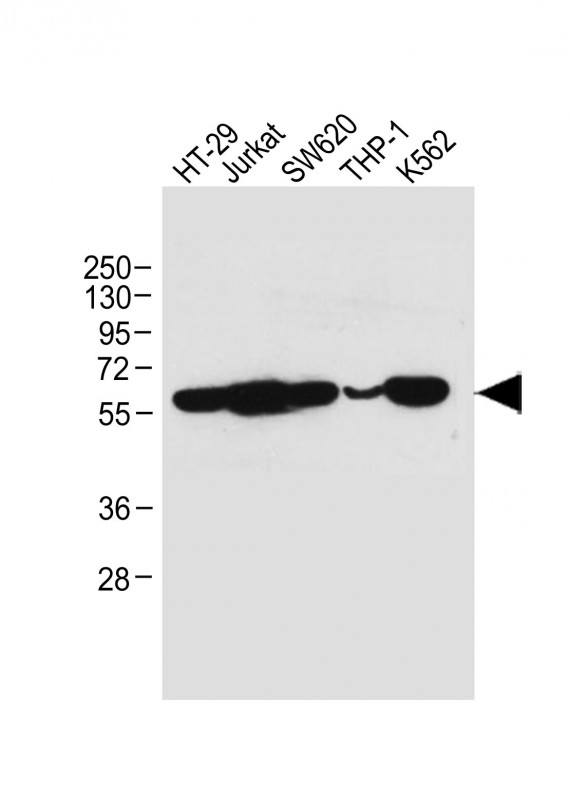
Mouse Anti-RIPK3 antibody
Receptor interacting protein 3; Receptor interacting serine threonine kinase 3; Receptor interacting serine/threonine protein kinase 3; Receptor-interacting protein 3; Receptor-interacting serine/threonine-protein kinase 3; RIP 3; RIP like protein kinase
View History [Clear]
Details
Product Name RIPK3 Chinese Name 受体结合丝氨酸苏氨酸激酶3单克隆抗体 Alias Receptor interacting protein 3; Receptor interacting serine threonine kinase 3; Receptor interacting serine/threonine protein kinase 3; Receptor-interacting protein 3; Receptor-interacting serine/threonine-protein kinase 3; RIP 3; RIP like protein kinase 3; RIP-3; RIP-like protein kinase 3; RIPK 3; RIPK3_HUMAN. Research Area Tumour Cell biology immunology Neurobiology Signal transduction Apoptosis transcriptional regulatory factor Immunogen Species Mouse Clonality Monoclonal Clone NO. D11F6 React Species Human, Applications WB=1:500-1000
not yet tested in other applications.
optimal dilutions/concentrations should be determined by the end user.Theoretical molecular weight 57kDa Cellular localization cytoplasmic The cell membrane Form Liquid Concentration 1mg/ml immunogen Recombinant human RIPK3. Lsotype IgG1,κ Purification affinity purified by Protein G Buffer Solution 0.01M TBS(pH7.4) with 1% BSA, 0.03% Proclin300 and 50% Glycerol. Storage Shipped at 4℃. Store at -20 °C for one year. Avoid repeated freeze/thaw cycles. Attention This product as supplied is intended for research use only, not for use in human, therapeutic or diagnostic applications. PubMed PubMed Product Detail The product of this gene is a member of the receptor-interacting protein (RIP) family of serine/threonine protein kinases, and contains a C-terminal domain unique from other RIP family members. The encoded protein is predominantly localized to the cytoplasm, and can undergo nucleocytoplasmic shuttling dependent on novel nuclear localization and export signals. It is a component of the tumor necrosis factor (TNF) receptor-I signaling complex, and can induce apoptosis and weakly activate the NF-kappaB transcription factor. [provided by RefSeq, Jul 2008]
Function:
Essential for programmed necrosis in response to death-inducing TNF-alpha family members. Upon induction of necrosis, RIPK3 interacts with, and phosphorylates RIPK1 to form a necrosis-inducing complex. RIPK3 binds to and enhances the activity of three metabolic enzymes: GLUL, GLUD1, and PYGL. These metabolic enzymes may eventually stimulate the tricarboxylic acid cycle and oxidative phosphorylation, which could result in enhanced ROS production.
Subunit:
Interacts (via RIP homotypic interaction motif) with RIPK1 (via RIP homotypic interaction motif); this interaction induces RIPK1 phosphorylation and formation of a RIPK1-RIPK3 necrosis-inducing complex. Upon TNF-induced necrosis, the RIPK1-RIPK3 dimer further interacts with PGAM5 and MLKL; the formation of this complex leads to PGAM5 phosphorylation and increase in PGAM5 phosphatase activity. Binds TRAF2 and is recruited to the TNFR-1 signaling complex. Interacts with PYGL, GLUL and GLUD1; these interactions result in activation of these metabolic enzymes. Interacts with BIRC2/c-IAP1, BIRC3/c-IAP2 and XIAP/BIRC4.
Subcellular Location:
Cytoplasm. Cell membrane. Mitochondrion (Potential).
Tissue Specificity:
Highly expressed in the pancreas. Detected at lower levels in heart, placenta, lung and kidney. Isoform 3 is significantly increased in colon and lung cancers.
Post-translational modifications:
RIPK1 and RIPK3 undergo reciprocal auto- and trans-phosphorylation. Phosphorylation of Ser-199 plays a role in the necroptotic function of RIPK3.
Polyubiquitinated with 'Lys-48' and 'Lys-63'-linked chains by BIRC2/c-IAP1 and BIRC3/c-IAP2, leading to activation of NF-kappa-B.
Similarity:
Belongs to the protein kinase superfamily. TKL Ser/Thr protein kinase family.
Contains 1 protein kinase domain.
SWISS:
Q9Y572
Gene ID:
11035
Database links:Entrez Gene: 11035 Human
SwissProt: Q9Y572 Human
Product Picture
Lane 1: HT-29 cell lysates
Lane 2: Jurkat cell lysates
Lane 3: SW620 cell lysates
Lane 4: THP-1 cell lysates
Lane 5: K562 cell lysates
Primary: Anti-RIPK3 (SLM-51714M) at 1/1000 dilution
Secondary: IRDye800CW Goat Anti-Mouse IgG at 1/20000 dilution
Predicted band size: 57 kD
Observed band size: 57 kD
Bought notes(bought amounts latest0)
No one bought this product
User Comment(Total0User Comment Num)
- No comment



 +86 571 56623320
+86 571 56623320




